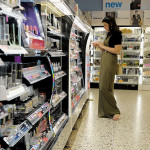As the sustainable fashion industry grows, we are in need of more information about what can help us, as consumers, determine between a sustainable piece, and one that pretends to be.
In order to help our readers understand what is and what isn’t sustainable in this growing market, I chatted with Ariel Azoff – a sustainable fashion entrepreneur, and founder & editor of the sustainable fashion blog HeartSleeves.
FGS What is ethical fashion?
AA: A very loose definition of ethical fashion is fashion that has been produced by people who work reasonable hours in safe conditions and are paid a living wage. I actually prefer the term “sustainable fashion” which encompasses both ethical fashion and fashion that is environmentally-friendly.
FGS: What are the requirements for something to be described as ethical fashion?
AA: Giving sustainable fashion a strict definition is difficult because there are so many different ways that it can manifest itself. In this day and age, with fashion’s notoriously-long supply chains, it’s difficult for designers to be perfect, but there many many ways for them to get on the right track.
In my definition of sustainable fashion, I include fashion that is: produced ethically, made using eco-friendly materials, made using recycled materials, up-cyled or repurposed, handmade, made locally, energy and resource efficient, and/or cruelty free.My philosophy is that it’s great if a product can fall into at least one of those categories, and my hope is that as the demand for sustainable fashion grows and sourcing becomes easier, designers will be able to cover more and more of them.
FGS: What are some of your favorite brands?
AA: There are so many! Definitely check out the designer profiles on my blog, I’m always learning about new inspiring people. I guess some of the most unique and sustainable lines that I’m a fan of are 100% NY (they’re almost zero-waste and incredibly conscious), Afia (Western trends blended with African prints and produced ethically in Ghana) and Study NY (the designer, Tara, is pretty much the queen of sustainable fashion). I also love love love the Elsa dress which is the sole style made by ELSA AND ME. It’s organic and made in New York and a classic cut that will never go out of style. In terms of jewelry I’ve been really into the line Dirty Librarian Chains lately. Susan, the designer, uses all reclaimed vintage materials and her jewelry is really unique and gorgeous.
FGS: Where do you feel ethical fashion is moving in terms of style, material, and the market?
AA: I’m really excited about where ethical and sustainable fashion are headed. Part of my mission at HeartSleeves is to make this type of apparel more accessible to the mainstream market because people still don’t know it’s out there or what it looks like. We’re not talking just hemp pants anymore, it’s now at an equal level of design with the rest of the fashion world. So the style is already there.
The market is following too. I love seeing sustainability creep into the mainstream. Gucci just made biodegradable shoes and Bottega Veneta made an eco-friendly handbag. H&M is now the world’s largest buyer of organic cotton. As demand grows, I think mainstream fashion can’t help but get on board. It’ll definitely be a long process, but we’re moving in the right direction.
FGS: What are some unique aesthetics or trends that it might have to offer the fashion market?
AA: The fashion world – and the science world as well – has been incredibly innovative in recent years in developing new sustainable textiles, many of which have superior qualities to the traditional textiles. Viscose fibers like Cupro, for example, are silky smooth and have amazing properties like being hypoallergenic, breathable, and stretch resistant.
With all of the great work that brands like Afia and the Andean Collection are doing with artisans around the world, I think there’s also a lot of opportunity for a more authentic version of the “indigenous” trend we saw recently. Then there are crazy things like dresses made from sour milk silk and pineapple silkthat will bring new textures into the mix for designers to play with. I can’t wait to see what they’ll come up with!
FGS: What are some common mistakes people make thinking they’re buying ethical, when they’re actually not?
AA: There’s definitely a problem with “greenwashing” when companies label products “green” because they think that’s what consumers want to hear, not because they are actually eco-friendly. One thing that I thought was sustainable when I first started researching this stuff is bamboo, but it turns out that the process to convert the fiber to fabric is often pretty wasteful and requires some harmful chemicals. So even conscious consumers are sometimes bamboozled! I find that buying second-hand is a great way to be sustainable about your shopping habits without having to worry about details.
FGS: What are some good resources for people trying to find out more about ethical fashion?
AA: There are a bunch of great blogs and magazines popping up now, and even mainstream sources like Vogue occasionally do a “green” spread. For news, you’ve got Ecouterre, Eco Fashion World, Eco Salon, Fashion Me Green, etc. There are more and more shopping sites popping up as well. There are boutiques like Kaight, Juno and Jove, Beklina and Future Standard, and then there are bigger web operations like Fashioning Change, JP Selects and Ethical Ocean.
I also highly recommend the book Where am I Wearing? by Kelsey Timmerman.


